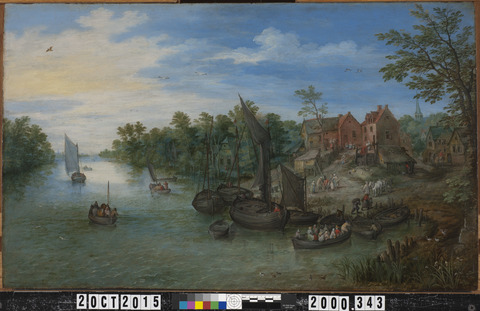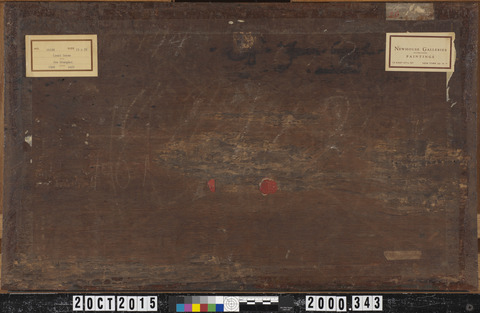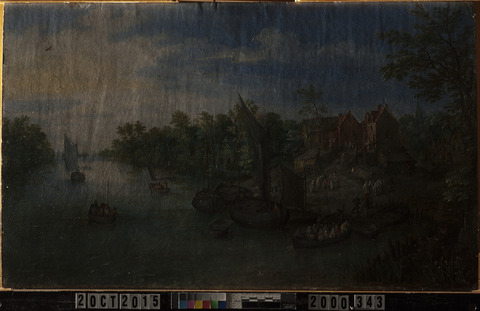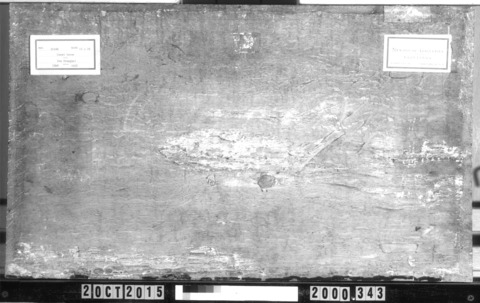Overview
Identification number: 2000.343
Artist: Jan Brueghel the Elder
Title: River Landscape
Materials: Oil on oak panel
Date of creation: 1612
Previous number/accession number: C10011
Dimensions: 37.8 cm × 61.7 cm
Conservator/examiner: Fiona Beckett and Roxane Sperber
Examination completed: 2015, revised 2020
Distinguishing marks:
Front:
Item 1. Inscription, front, bottom left: “BRUEGHEL 1612” painted in umber (tech. figs. 1–3).
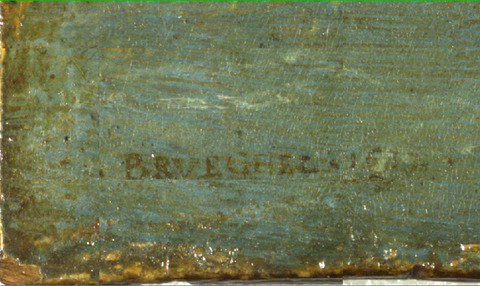


Item 2: Inscription, front, bottom left above signature under the paint: “252” in iron-containing chalk (see tech. fig. 2, 4).
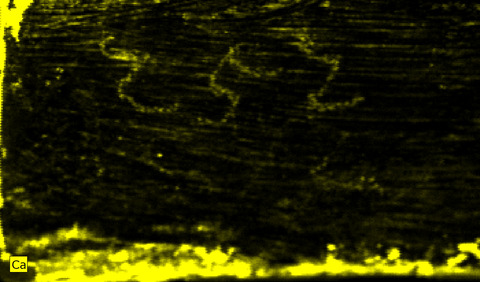
Item 3. Painted inscription, bottom-right corner, front: “708”
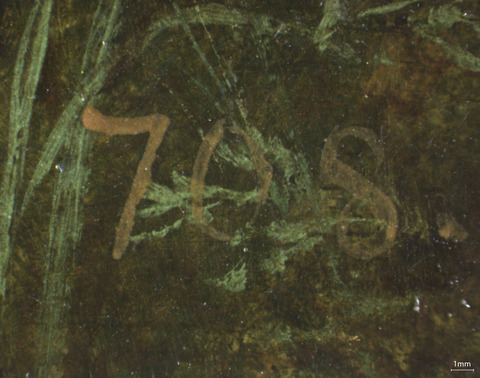
Back:
Item 4. Red seal, back, lower half of panel, bearing a coat of arms (tech. fig. 6, 7). The seal covers a piece of paper which may have been held in place between the two seals.
Item 5. Partial red seal on back, lower half of panel (tech. fig. 6, 8).
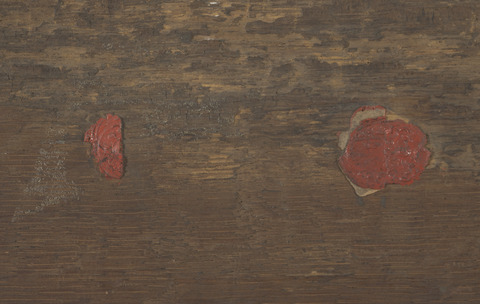
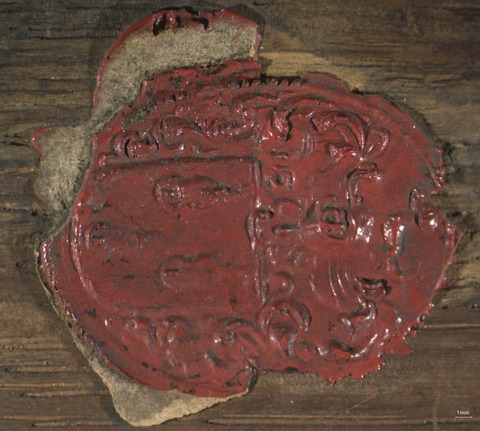

Item 6. Off-white label, back, upper-right corner with brown border and typing: “NEWHOUSE GALLERIES INCORPORATED PAINTINGS 15 EAST 57th ST. NEW YORK 22 N.Y.” (tech. fig. 9).
Item 7. Off-white paper tape, back, top right with red numbers: “20” (tech. fig. 9).
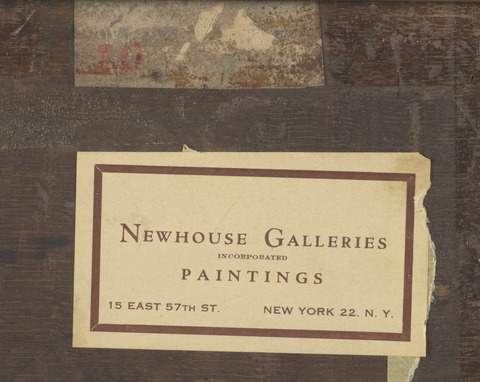
Item 8. Off-white label, back, upper left: “No. 16144 SIZE 15 × 24 TITLE River Landscape ARTIST Jan Brueghel 1568-1625”

Item 9. Black handwriting on back of panel: “…J..an Bruegel/anuersa” (tech. figs. 11–14).
Item 10. Off-white stained label, back, upper half, central, illegible (tech. fig. 11).
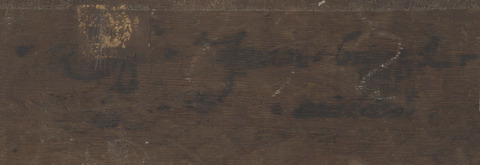



Item 11. Off-white tape with writing, back, bottom right: “N° 252 v. Hand Breu...”

Summary of Treatment History
Letters from Bert Newhouse to George H.A. Clowes indicate the painting was treated in the spring of 1958 before Clowes purchased it. Newhouse praises the pristine condition of the work, writing on 25 April 1958, “In connection with the Breughel, no one knows better than you, Doctor, that this picture is unique. It is in perfect state, it is of the most valuable period, and it has the most exciting history.” 1 In a letter from Clowes to Newhouse, dated the same day, Clowes mentions that he looks forward to seeing the Brueghel that was being cleaned at that time.2 A letter from July of that year confirms that the Brueghel was in fact cleaned.3
Documentation suggests a series of condition assessments and treatments were carried out on the collection around the time the works were moved from the Clowes' residence to the IMA in 1971. A condition report by Paul Spheeris in October of that year, likely carried out before the paintings were relocated, described the painting as “O.K” and recommended no treatment.4 A second condition assessment was carried out upon arrival of the paintings at the IMA. This assessment described the work as in “excellent condition,” and no treatment was deemed necessary.5 The paintings has not been treated since its arrival at the IMA in 1971.
The painting was previously examined and documented in the annual Clowes Reports from 2011–2020.
Current Condition Summary
Structurally, the painting is in stable condition with no interventions applied to the panel. There is a slight convexity in the panel from previous response to moisture. Aesthetically the painting is in good condition, with some age cracks present and residues of natural resin varnish in some areas.
Methods of Examination, Imaging, and Analysis:
| Examination/Imaging | Analysis (no sample required): | Analysis (sample required): |
|---|---|---|
Unaided eye | Dendrochronology | Microchemical analysis |
Optical microscopy | Wood identification | Fiber ID |
Incident light | Microchemical analysis | Cross-section sampling |
Raking light | Thread count analysis | Dispersed pigment sample |
Reflected/specular light | X-ray fluorescence spectroscopy (XRF) | Fourier-transform infrared spectroscopy (FTIR) |
Transmitted light | Macro X-ray fluorescence scanning (MA-XRF) | Raman microspectroscopy |
Ultraviolet-induced visible fluorescence (UV) | ||
Infrared reflectography (IRR) | Gas chromatography–mass spectrometry (GC-MS) | |
Infrared transmittography (IRT) | Scanning electron microscope -energy dispersive X-ray spectroscopy (SEM-EDS) | |
Infrared luminescence | Other: | |
X-radiography |
Technical Examination
Description of Support:
Analyzed Observed
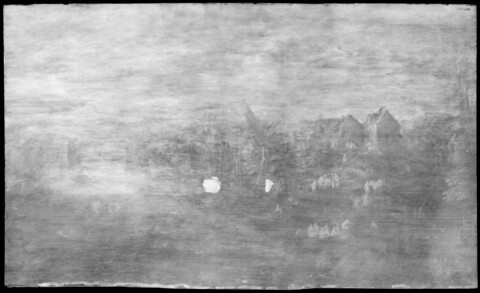
Material Type (fabric, wood, metal, dendrochronology results, fiber ID information, etc.):
The painting is on eastern Baltic oak panel, cut from a slow-growing and straight-grain tree with horizontally oriented grain (tech. fig. 16). The last growth ring from the heartwood dates to 1597. With the addition of 8 years for sapwood growth, the tree was likely felled after about 1605. Dendrochronologist Ian Tyers calculated the likely usage range of between about 1605 and 1637.6 This is consistent with the inscribed date of 1612.
Characteristics of Construction/Fabrication (cusping, beveled edges of panels, seams or joins, battens):
The panel is a single piece of wood with beveled edges on all four sides of the back. The panel is somewhat wider than is typical, suggesting the board was not trimmed before use.7 Evidence of a riven surface is visible on the back.8 The panel was then hand-tooled, and the smoothing marks can be seen with raking light on the back (tech. fig. 17). These are also visible on the front (although less so due to the presence of the ground and paint layer). The bevels along all four edges indicate that the panel is the same size as originally constructed and that no alterations have taken place.

A wood knot is present in the back (tech. fig. 18). The panel is almost radially sawn, indicating that it was cut from the most stable section of the log. Despite this, a slight warp is still present, likely due to the application of the paint on one side coupled with environmental fluctuations in moisture and temperature.
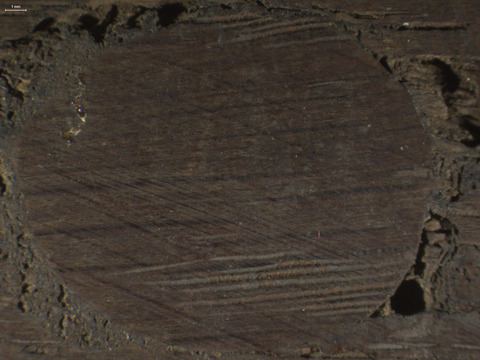
Thickness (for panels or boards):
0.3–0.4 cm
The panel is relatively thin and even throughout and remains somewhat flexible due to its thin dimension.
Production/Dealer’s marks:
A partial red seal that has a coat of arms with three elements (tech. fig. 1), as yet unidentifiable, is visible on the back. A second red seal with an illegible impression is also present nearby. A dealer’s label from Newhouse Galleries New York is also present (see Distinguishing Marks for more details).
Weave (structure, weight, thread thickness, etc):
N/A
Auxiliary Support:
Original Not original Not able to discern None
Condition of Support
The panel exhibits a convex warp of approximately 0.8 cm at the center. The panel is currently in stable condition, and no warping has occurred recently. The front of the panel is in excellent condition despite the convexity. The warp is slightly uneven, with the bottom edge of the panel having slightly less deformation than the upper edge. This is possibly related to the beveled edge. Some old gouges are present on the back of the panel—these may have occurred at the time the panel was created, but also possibly sometime after.
Description of Ground
Analyzed Observed
Materials/Binding Medium:
The ground is composed of a calcium-containing material likely to be calcium carbonate (chalk). The use of chalk grounds is common for northern European panel paintings. The detection of calcium in all XRF locations supports this suggestion (see table 1). Further, the calcium map in a detail of the trees clearly shows calcium build-up in the interstices of the wood grain of the panel (tech. fig. 19, 20). For the calcium to penetrate the interstices of the wood grain, it must be in a calcium-containing ground layer.
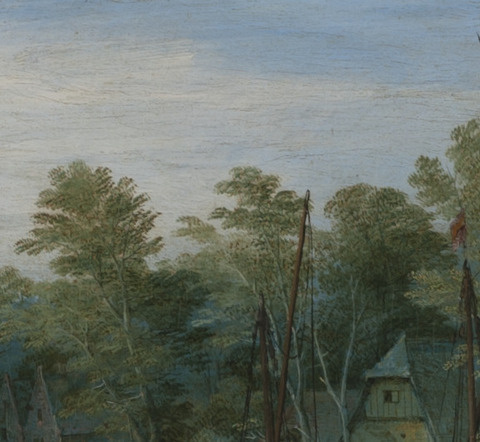
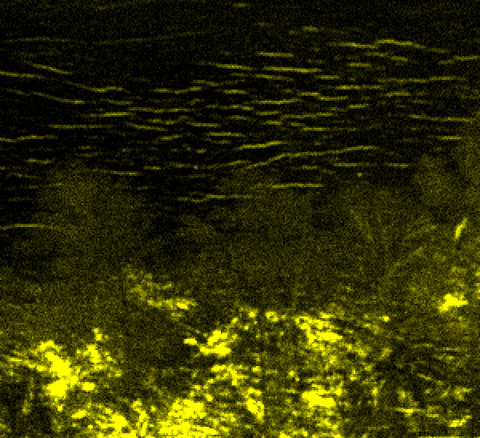
It also appears that a lead-white-containing imprimatura, a common feature in Brueghel the Elder’s paintings, was also applied.9 The infrared reflectogram shows sweeping strokes of paint across the entire surface that likely correspond to the imprimatura (tech. fig. 21). Further tests would be necessary to determine the exact layer structure.
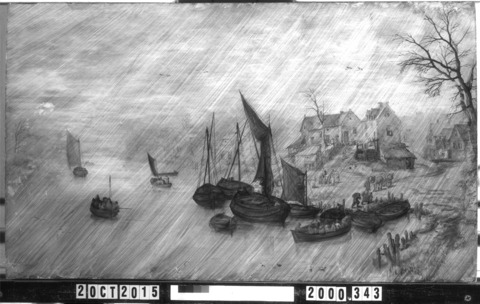
Color:
Off-white
Application:
Sweeping, diagonal brush marks are easily seen across the composition in infrared reflectography (tech. fig. 21). This may be from the application of the ground, but perhaps more likely an artist-applied imprimatura.
Thickness:
Appears to be a single layer of medium-thickness gesso.
Sizing:
While not discernible, an animal-glue size layer (or several layers) would likely have been applied to the panel prior to the application of the ground.
Character and Appearance (Does texture of support remain detectable/prominent?):
The texture of the wood panel remains detectable through the ground and paint layers.
Condition of Ground
Where visible, the ground appears to be in stable condition. Craquelure in the ground layer is associated with the movement of the panel over time and does not appear to have changed recently. The adhesion between the ground and the panel, as well as the ground and paint layers, is good. Previous restoration efforts include minor fills along the edges where there were losses or abrasions in the ground layer. These appear to be in stable condition.
Description of Composition Planning
Methods of Analysis:
Surface observation (unaided or with magnification)
Infrared reflectography (IRR)
X-radiography
Analysis Parameters:
| X-radiography equipment | GE Inspection Technologies Type: ERESCO 200MFR 3.1, Tube S/N: MIR 201E 58-2812, EN 12543: 1.0mm, Filter: 0.8mm Be + 2mm Al |
|---|---|
| KV: | 21 |
| mA: | 3 |
| Exposure time (s) | 90 |
| Distance from x-ray tube: | 36” |
| IRR equipment and wavelength | Opus Instruments Osiris A1 infrared camera with InGaAs array detector operating at a wavelength of 0.9-1.7µm. |
Medium/Technique:
Fluid medium, possibly carbon black paint or ink
Pentimenti:
Underdrawing is present throughout the painting in the form of fluid black lines (tech. fig. 22). These are also visible with the unaided eye. Some adjustments and refining of the figures and boats were made during the planning stages (tech. fig. 23), although no major changes are present. The fluid black lines appear to be executed in paint, and the same black lines appear overtop of additional paint layers to reinforce and further outline the compositional elements. The diagonal brush marks of the ground application are even more apparent in infrared reflectography. The back of the panel does not show any additional information regarding the handwritten ink inscription, as it is not visible when viewed with the Osiris infrared camera, perhaps indicating an iron gall ink.
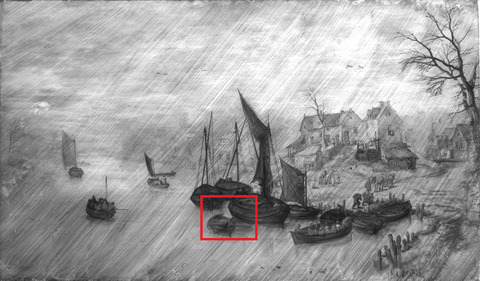
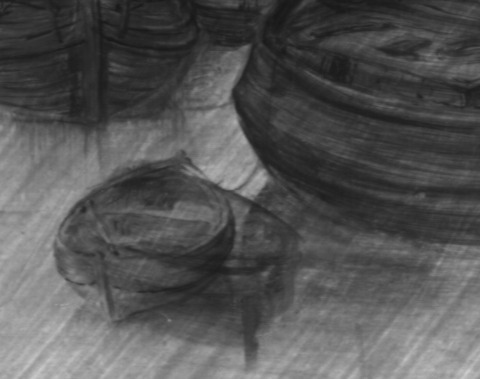
Description of Paint
Analyzed Observed
Application and Technique:
Areas of color were first applied in broad strokes to block in the areas of sky, river, foreground, and buildings. After this, both wet-over-dry (tech. fig. 24) and wet-in-wet painting techniques were used to create the detailed elements of the composition. The paint was applied delicately with attention to the individual character of each of the small figures (tech. figs. 24–29). This style can be differentiated from less technically accomplished, more formulaic works where figures are painted quickly and without individuality.
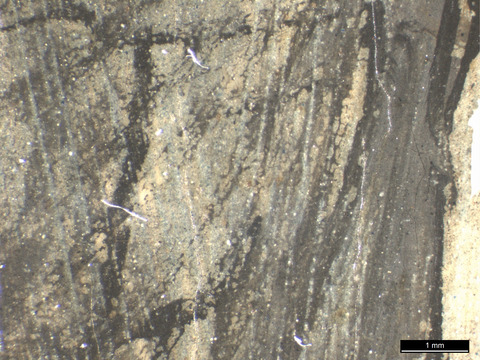
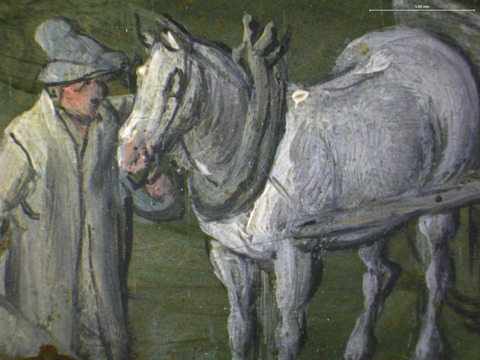


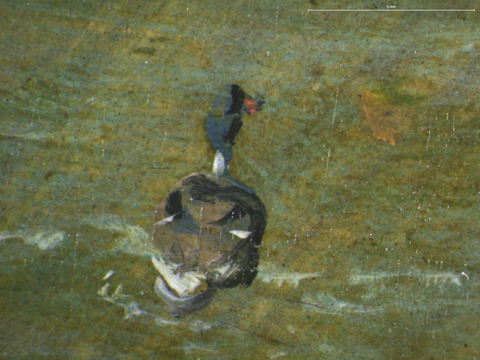
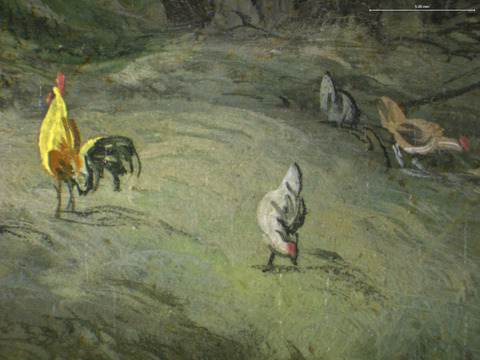
MA-XRF scanning of the woman walking with a child illuminates how these expressive figures were painted. Over the copper-containing foreground layer (tech. fig. 32, green), outlining in an umber pigment was used to capture the gesture of the figure. This umber outlining is visible in the manganese distribution map (tech. fig. 31, magenta). Some of this outlining is visible in the final version (tech. fig. 30), but other areas are concealed by areas of color that were applied over the umber sketch. Interestingly, no umber outlining is present in the figure of the boy, perhaps suggesting that he was added as an afterthought.

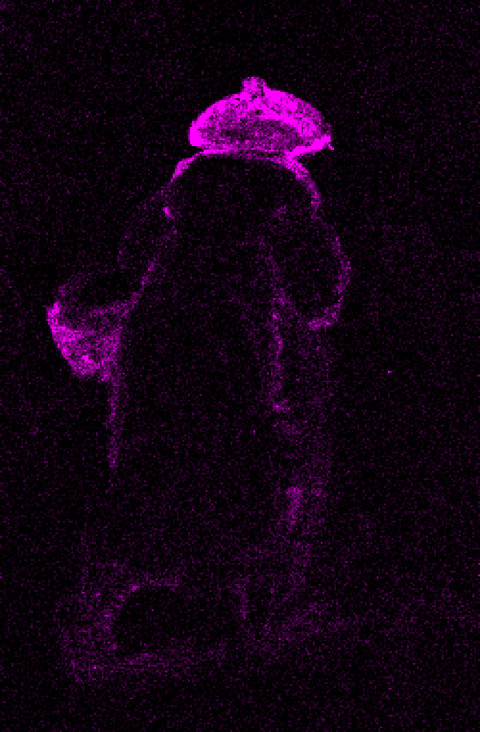
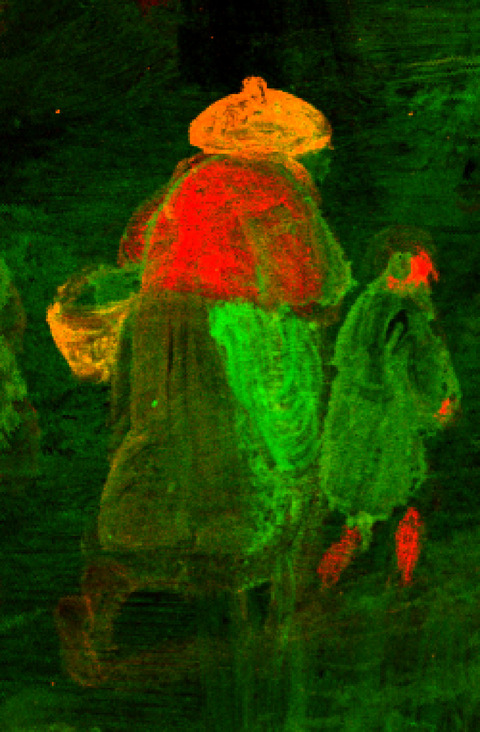
Technical figure 32 shows the elemental distribution map for the pigments that were used to paint the woman’s and boy’s clothes. Mercury (red) indicates the use of vermilion in her shirt, copper (green) indicates the use of azurite and/or verdigris in the woman’s skirt and the boy’s clothes, and iron (orange) in the hat and basket is derived from umber. The distribution of iron corresponds to the manganese map (tech. fig. 31), suggesting umber was used both for the outlining of the figure and in the paint layer. Final outlining in a carbon black pigment was used to define each fold on the woman’s clothes and is used in the outlining of the boy.
While the panel is generally smooth, dabs of impasto applied with a stiff brush create the appearance of detailed masonry in the buildings and of highlights on the glittering leaves of the trees (tech. figs. 33, 34). In the trees, lead-tin yellow was mixed with the copper-containing green pigments in the leaves to create thick dabs of yellow highlights (tech. fig. 34 see also tech. figs. 38, 39).
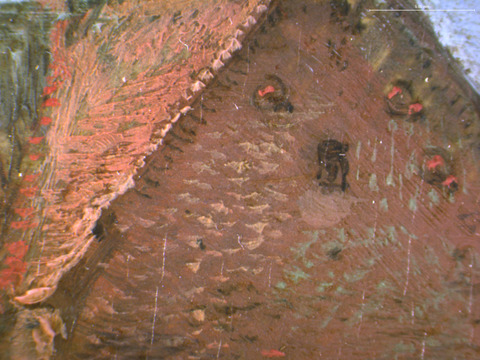
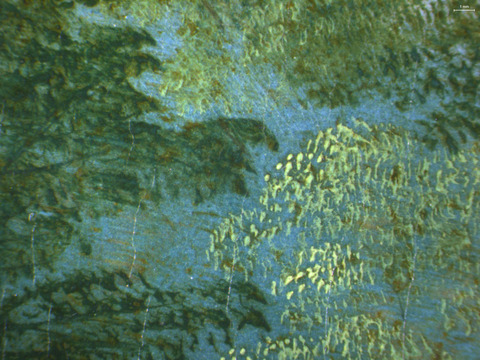
Rigging and outlines in the boats as well as the tree trunks were painted using an iron-rich pigment (tech. fig. 40) with final detailing in carbon black.
Painting Tools:
Medium and small brushes
Binding Media:
The binding media is most likely oil (untested).
Color Palette:
The color palette is composed primarily of vibrant blues and greens with highlights of yellow and red (tech. fig. 37). Gray, brown, umber, and black are used for the houses, boats, figures, and outlining. Small figures in the landscape have brightly colored clothing that punctuates the landscape with splashes of red, yellow, and white. The greens in the trees appear to be painted using a transparent series of glazes, not uncommon for Brueghel’s working technique.
XRF Analysis:
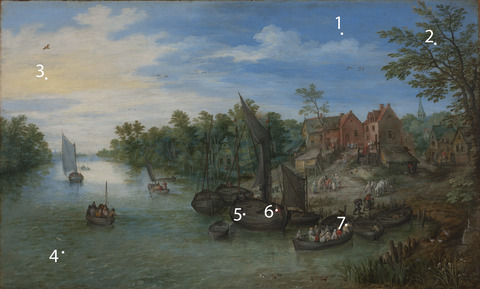
| Sample | Location (x, y) | Elements | Possible Pigments |
|---|---|---|---|
| 1 | Blue in sky | Major: Pb Minor: Ca Trace: Si, Al, Cu, K, Fe, Mn, Ti | Lead white, calcium (from ground layer), iron oxide (earth pigments), traces of aluminum and silicon may indicate the presence of ultramarine, trace of copper-containing blue and/or green pigment. |
| 2 | Green in trees | Major: Pb, Cu Minor: Trace: Fe, Sn, Ca, Si, Ti, K | Copper-containing green and/or blue pigment (likely verdigris), lead white, iron oxide (earth pigments), trace of lead-tin yellow, calcium (from ground layer) |
| 3 | Yellow in sky | Major: Pb Minor: Trace: Ca, Fe, Mn | Lead white, traces of calcium (from ground layer), trace of iron oxide (earth pigment) |
| 4 | Water in foreground | Major: Cu, Pb Minor: Ca Trace: Fe | Copper-containing blue and/or green pigment (likely azurite and/or copper resinate), lead white, calcium (from ground layer), traces of iron oxide (earth pigments) |
| 5 | Black in boat outline | Major: Pb, Cu Minor: Ca, Fe Trace: Mn, Ti | Copper-containing blue and/or green pigment (likely azurite and/or copper resinate), lead white, calcium (from ground layer), traces of iron oxide (earth pigments) |
| 6 | Red in boater’s coat | Major: Pb, Hg Minor: Cu Trace: Ca, Fe, Mn, Si, K | Lead white, vermilion, copper-containing blue and/or green pigment (likely azurite and/or copper resinate), calcium (from ground layer), trace of iron oxide (earth pigments). |
| 7 | Yellow in boater’s coat | Major: Pb, Cu Minor: Fe Trace: Ca, Hg | Iron oxide (earth pigments likely yellow ocher), lead white, copper-containing blue and/or green pigment (likely azurite and/or copper resinate), trace of vermilion, trace of calcium (from ground layer). |
Table 1: Results of x-ray fluorescence analysis conducted with a Bruker Artax microfocus XRF with rhodium tube, silicon-drift detector, and polycapillary focusing lens (~100 μm spot).
*Major, minor, trace quantities are based on XRF signal strength not quantitative analysis
XRF analysis (tech. fig. 35, table 1) and MA-XRF scanning (tech. figs. 37-40) suggest the presence of lead white, copper-containing blue and/or green pigments (likely azurite and verdigris), vermilion, iron oxide (earth pigments including umber), and lead-tin yellow. Raman analysis conducted on blue particles in the sky identified natural ultramarine was used to paint the cool blue (tech. fig. 36).
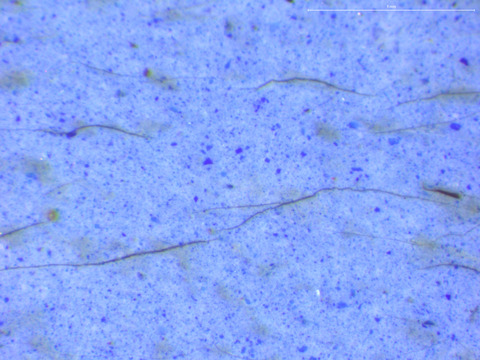
The delicate contrast of the bright blue sky with the greenish-blue water is notable. MA-XRF analysis indicates a very different pigment mixture was used in the sky from the foreground and water. The MA-XRF elemental distribution map for copper (tech. fig. 38) clearly shows the use of copper-containing pigments in the foreground but not the sky, which Raman spectroscopy confirmed contains ultramarine blue.
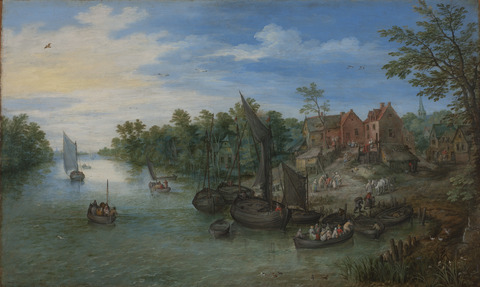

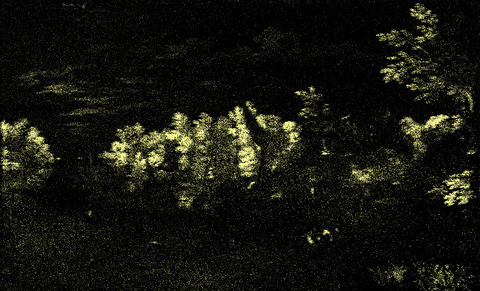
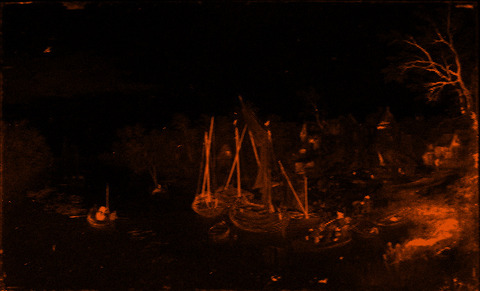
Lead was identified throughout the painting using XRF and MA-XRF, indicating the widespread use of lead white. Vermilion was used for the bright reds. Although not detectable using XRF, the blacks are almost certainly carbon black. Tin was detected in the highlights of the foliage and some of the figures' clothing, suggesting the presence of lead-tin yellow in these areas (tech. fig. 39). Iron does not appear to be present in the leaves of the trees suggesting the primary yellow color in the foliage was lead-tin yellow. Yellow ocher, as well as other iron-containing brown earth pigments are also present in the trunks of the trees and foreground (tech. fig. 40).
Surface Appearance:
The paint texture maintains partial shapes of the brush strokes and also shows some of the craquelure originating in the ground layer, consistent with that of panel paintings. The craquelure does not interfere with the reading of the painting’s subject matter.
Condition of Paint:
The paint layer is in excellent condition for a work of this age. The lack of structural interventions to the panel has spared it from damage typically seen on so many cradled panel paintings. It also provides an example of a seventeenth-century panel preparation. When viewed under the microscope, small lead white soaps, which appear as white protrusions from the paint, can be seen in some of the darker painted areas. Age craquelure is present throughout the paint layer and remains stable. There is some wear of the paint along all four edges where the painting is in contact with the frame. Some engrained dirt is present mostly along the edges but can also be seen in some of the cracks.
Description of Varnish/Surface Coating
Analyzed Observed Documented
| Type of Varnish | Application |
|---|---|
Natural resin | Spray applied |
Synthetic resin/other | Brush applied |
Multiple Layers observed | Undetermined |
No coating detected |
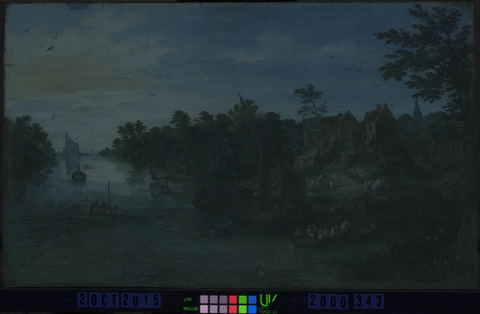
A natural resin varnish was applied to the surface at one point during the painting’s history. It was later removed, leaving residues visible in the depressions of the paint and along the edges. These can be seen easily under the microscope and with ultraviolet-induced visible fluorescence (tech. fig. 41). A synthetic varnish was later applied evenly over the entire surface. The varnish is glossy and adequately saturates the paint layers. Retouching is present in small amounts and was done relatively delicately with a small brush, matching the surrounding paint.
Condition of Varnish/Surface Coating
The varnish is in good condition. A few minor scuffs and scratches are visible in the surface, but no major damages or blooming. The painting was likely cleaned relatively recently, but before entering the IMA in 1971. There is no dust or dirt on the surface.
Description of Frame
Original/first frame
Period frame
Authenticity cannot be determined at this time/ further art historical research necessary
Reproduction frame (fabricated in the style of)
Replica frame (copy of an existing period frame)
Modern frame
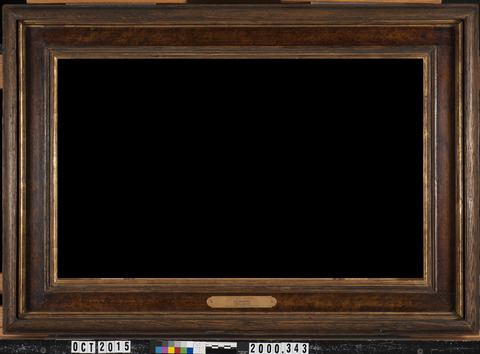
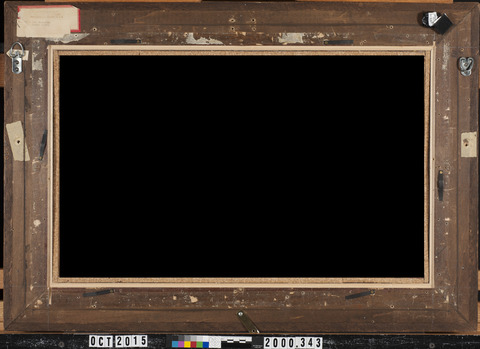
Frame Dimensions:
Outside frame dimensions: 54.5 × 78.5 × 6 cm
Sight size: 36.5 × 60 cm
Distinguishing Marks:
Item 11. Off-white label back, top left: “No. 25 – Jan Breughel River Landscape”
Item 12. Off-white label with double red border, back, top left, partially obscured: “THE CLOWES FUND INCORPORATED FINE ARTS DEPARTMENT 3744 SPRING HOLLOW ROAD INDIANAPOLIS 8, INDIANA, U.S.A.”
Item 13. Off-white label, back, upper left, obscured by d-ring: “TR#__”
Description of Molding/Profile:
The frame is composed of four members with mitered corners (tech. fig. 43). The wood is stained a dark brown. The frieze appears to have a veneer of a more textured wood such as walnut. The inner lip as well as a portion of the outer edge of the veneer have water gilding with a red bole layer underneath. The frieze has a shellac layer (tech. fig. 42), which is evident from the orange fluorescence under ultraviolet-induced visible fluorescence.
Condition of Frame:
General wear is present throughout the frame with areas of wood stain rubbed off. Some of the gilding is also worn, but this may have been deliberately done at the time the frame was created to create a less pristine appearance. The frame is in stable condition and adequately houses the painting, especially with the adjustments made to fit the natural convexity of the panel.
Notes
-
Letter from Bert Newhouse to G.H.A. Clowes, 25 April 1958, Correspondence Files, Clowes Registration Archive, Indianapolis Museum of Art at Newfields. ↩︎
-
Letter from G.H.A. Clowes to Bert Newhouse, 25 April 1958, Correspondence Files, Clowes Registration Archive, Indianapolis Museum of Art at Newfields. ↩︎
-
Letter from G.H.A. Clowes to Bert Newhouse, 19 July 1958, Correspondence Files, Clowes Registration Archive, Indianapolis Museum of Art at Newfields. ↩︎
-
2 Paul A.J. Spheeris. 25 Oct 1971, “Conservation Report on the Condition of the Clowes Collection,” Clowes Conservation Department Files, Indianapolis Museum of Art at Newfields. ↩︎
-
Martin Radecki, Clowes Collection condition assessment, undated (after October 1971), Conservation Department Files, Indianapolis Museum of Art at Newfields. ↩︎
-
Ian Tyers, “Tree-Ring Analysis and Wood Identification of Paintings from the Indianapolis Museum of Art: Dendrochronological Consultancy Report 1082,” January 2019, p. 8, Conservation Department files, Indianapolis Museum of Art at Newfields. ↩︎
-
Ian Tyers, “Tree-Ring Analysis and Wood Identification of Paintings from the Indianapolis Museum of Art: Dendrochronological Consultancy Report 1082,” January 2019, p. 8, Conservation Department files, Indianapolis Museum of Art at Newfields. ↩︎
-
Ian Tyers, “Tree-Ring Analysis and Wood Identification of Paintings from the Indianapolis Museum of Art: Dendrochronological Consultancy Report 1082,” January 2019, p. 8, Conservation Department files, Indianapolis Museum of Art at Newfields. ↩︎
-
Anne Haack et al., “Christ Driving the Traders from the Temple: Painting Materials and Techniques in the Context of 16th-Century Antwerp Studio Practice,” in Erma Hermens, ed. On the Trail of Bosch and Brueghel: Four Paintings United under Cross-Examination, CATS Series of Technical Studies (London: Archetype Publications Ltd., 2012), 29. ↩︎
Additional Images
